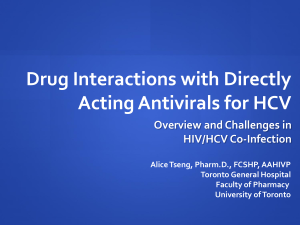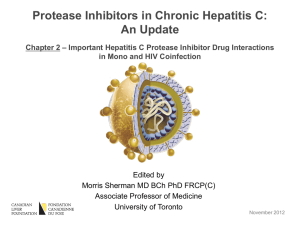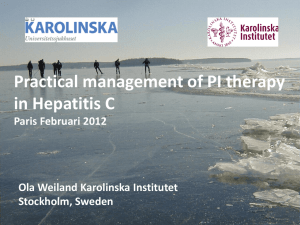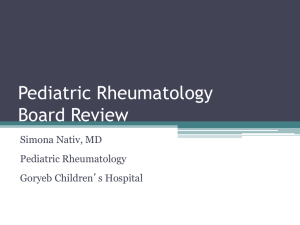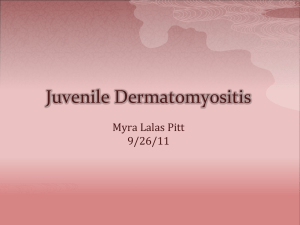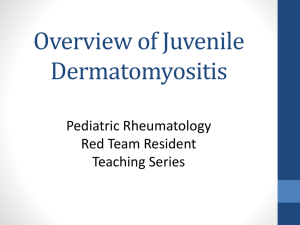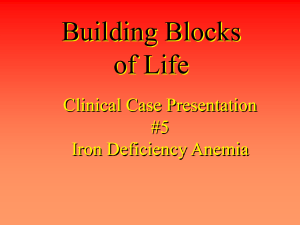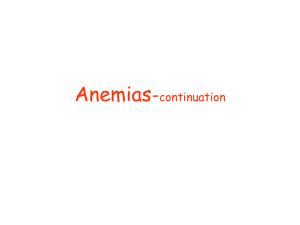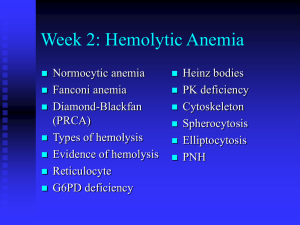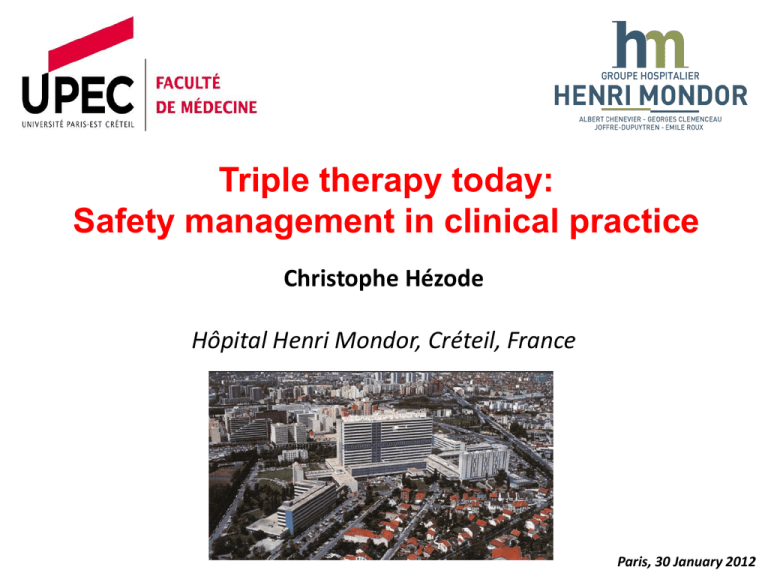
Triple therapy today:
Safety management in clinical practice
Christophe Hézode
Hôpital Henri Mondor, Créteil, France
Paris, 30 January 2012
Telaprevir placebo-controlled Phase II/III studies:
summary of AEs during telaprevir/placebo phase
Patients, %
T12/PR
(750 mg q8h)
n=1346
Placebo/PR48
n=764
Leading to
discontinuation of all
study drugs*(%)
Skin and subcutaneous tissue disorders
Pruritus (SSC)
52
26
0.6%
Rash (SSC)
55
33
2.6%
32
15
0.9%
Nausea
39
29
<0.5
Diarrhea
26
19
<0.5
Hemorrhoids
12
3
<0.5
Anorectal discomfort
8
2
<0.5
Anal pruritus
6
1
<0.5
Blood and lymphatic system disorders
Anemia (SSC)
Gastrointestinal disorders
*Discontinuation of all study drugs in the T12/PR arms (analyzed within SSC for
rash and anemia)
SSC: special search category
http://www.fda.gov/downloads/AdvisoryCommittees/Committees/Meeting
Materials/Drugs/AntiviralDrugsAdvisoryCommittee/UCM252562.pdf
Boceprevir Phase III studies: summary of AEs
over course of therapy
Patients, %
BOC RGT
BOC44/PR48
PR
n=368
n=366
n=363
Anemia*
49
49
29
Dysgeusia*
37
43
18
Grade 3-4 neutropenia (500 to <750/mm3
and <500/mm3)
29
33
18
n=162
n=161
n=80
Anemia*
43
46
20
Dysgeusia*
43
45
11
Dry skin**
21
22
8
Grade 3-4 neutropenia (500 to <750/mm3
and <500/mm3)
25
27
13
17
14
5
SPRINT-2 (naïve)1
RESPOND-2 (experienced)2
Rash
‡
*p<0.001 for boceprevir arms versus PR
**p=0.009 (BOC RGT) and p=0.004 (BOC44/PR48) versus PR
‡p=0.01 (BOC RGT) and p=0.05 (BOC44/PR48) versus PR
1. Poordad F, et al. N Engl J Med 2011;364:1195–206
2. Bacon BR, et al. N Engl J Med 2011;364:1207–17
Specific adverse events
with DAAs: rash
Grading of skin eruption severity
Mild: localized skin eruption and/or a skin eruption with limited
distribution (up to several isolated sites on the body)
•
Week 3
•
Focal maculo-papular lesions of
the trunk (grade 1)
•
Moderate pruritus
•
No criteria of severity
Cacoub P et al, J Hepatol 2012;56:455-63
Grading of skin eruption severity
Mild: localized skin eruption and/or a skin eruption with limited
distribution (up to several isolated sites on the body)
Moderate: diffuse rash involving ≤50% of body surface area
•
Week 6
•
Maculo-papular rash
of the trunk and
limbs (grade 2)
•
Moderate pruritus
•
No criteria for
severity
Cacoub P et al, J Hepatol 2012;56:455-63
Grading of skin eruption severity
Mild: localized skin eruption and/or a skin eruption with limited
distribution (up to several isolated sites on the body)
Moderate: diffuse rash involving ≤50% of body surface area
Severe: extent of rash >50% of body surface area or associated
with significant systemic symptoms, mucous membrane
ulceration, target lesions, epidermal detachment
Cacoub P et al, J Hepatol 2012;56:455-63
Estimating body surface area (BSA)
9%
Adult body
Front
18%
Back
18%
9%
18%
9%
BSA
Perineum
1%
Arm
9%
Head (front and back)
9%
Leg
18%
Chest
18%
Back
18%
18%
Hettiaratchy S, et al. BMJ 2004;329:101–3
Incidence of rash (%)
Incidence of rash (%)
Summary of rash data from placebo-controlled
Phase II and III trials: telaprevir treatment phase
(n=1346)
>90% of all rash =
mild/moderate
(n=764)
Features:
Typically pruritic and eczematous, and involving <30% BSA
Progression was infrequent (<10% of cases)
T12/PR arm
Time to onset:
Approximately 50% of rashes started during the first 4 weeks
But rash can occur at any time during telaprevir treatment
Cacoub P et al, J Hepatol 2012;56:455-63
Grading of skin eruption severity
Mild: localized skin eruption and/or a skin eruption with limited
distribution (up to several isolated sites on the body)
Moderate: diffuse rash involving ≤50% of body surface area
Severe: extent of rash >50% of body surface area or associated
with significant systemic symptoms, mucous membrane
ulceration, target lesions, epidermal detachment
SCAR: Collective term for severe drug-related skin conditions that
can be associated with significant morbidity
SCAR: Severe Cutaneous Adverse Reaction
Cacoub P et al, J Hepatol 2012;56:455-63
Severe Cutaneous Adverse Reaction: SCAR
reported with telaprevir
Collective term for severe drug-related skin conditions that can be associated
with significant morbidity
SCAR
encompasses
several
conditions
Acute generalized
exanthematous pustulosis
(AGEP) and Erythema
Multiforme Major (EMM)
Toxic epidermal necrolysis
(TEN) and Stevens-Johnson
Syndrome (SJS)
Drug rash/reaction with
eosinophilia and systemic
symptoms (DRESS)
3 cases suggestive of SJS*
(of which 1 case considered not related to telaprevir,
onset 11 weeks after telaprevir discontinuation)
11 cases suggestive of DRESS*
*In placebo-controlled Phase II/III trials, 0.4% of patients had suspected DRESS;
in telaprevir clinical experience, less than 0.1% of patients had SJS
Cacoub P et al, J Hepatol 2012;56:455-63
When to suspect DRESS
•
Alert criteria:
– Onset from 6–10 weeks after first
dose
– Rapidly progressing exanthema
– Prolonged fever (>38.5°C)
– Facial oedema
What to do?
If any DRESS alert criteria are found, the patient should be
assessed for the following confirmation criteria
–
–
–
–
Enlarged lymph nodes (at least 2 sites)
Eosinophilia (≥700/μL or ≥10%)
Atypical lymphocytes
Internal organ involvement
– Liver: ALT, alkaline phosphatase ≥2 x upper limit of normal
– Kidney: rise in creatinine ≥150% basal level
If any DRESS confirmation criteria are also found:
– Stop all drugs
– Hospitalize the patient
– Consult a dermatologist
Cacoub P et al, J Hepatol 2012;56:455-63
When to suspect SJS/TEN
•
•
•
•
•
Rapidly progressing exanthema
Skin pain
Mucosal involvement at ≥2 sites
Blisters or epidermal detachment
Atypical/typical target lesions
What to do?
Stop all drugs
Hospitalize the patient
Consult a dermatologist
Cacoub P et al, J Hepatol 2012;56:455-63
Drug considerations: mild and moderate rash
Monitor for progression or systemic symptoms until the
rash is resolved
Mild
Moderate
Rash
For moderate rash, consider consultation with a
dermatologist. For moderate rash that progresses, permanent
discontinuation of telaprevir should be considered
If the rash does not improve within 7 days following telaprevir
discontinuation, ribavirin should be interrupted. Interruption of
ribavirin may be required sooner if the rash worsens despite
discontinuation of telaprevir
Peginterferon alfa may be continued unless interruption is
medically indicated
For moderate rash that progresses to severe (≥50% body
surface area), permanently discontinue telaprevir
Treating patients with mild or moderate rash
Emollients
Topical corticosteroids
Permitted systemic antihistaminic drugs may be tried for the treatment of associated pruritus
Limit exposure to sun/heat and wear loose-fitting clothes
Add oatmeal to bathing water
Cacoub P et al, J Hepatol 2012;56:455-63
Drug considerations: severe rash and SCAR
Severe: extent of rash >50% of body surface area or associated with significant systemic symptoms,
mucous membrane ulceration, target lesions, epidermal detachment
SCAR: generalized bullous eruption, drug rash with eosinophilia and systemic symptoms (DRESS),
Stevens-Johnson Syndrome (SJS)/toxic epidermal necrolysis (TEN), acute generalized exanthematous
pustulosis (AGEP), erythema multiforme (EM)
Permanently discontinue telaprevir immediately.
Consultation with a dermatologist is needed
Rash
Severe
SCAR
Monitor for progression or systemic symptoms until
the rash is resolved. If no improvement within 7 days
of stopping telaprevir (or earlier if rash worsens),
sequential or simultaneous interruption or
discontinuation of ribavirin and/or peginterferon
should be considered
Permanent and immediate discontinuation of
telaprevir, peginterferon and ribavirin is required
Consult with a dermatologist
TELAPREVIR must not be restarted if discontinued
Cacoub P et al, J Hepatol 2012;56:455-63
Specific AEs with DAAs:
anemia
Summary of anemia data from the boceprevir
SPRINT-2 study over course of therapy
• Incidence and severity of anemia increased with boceprevir
combination treatment compared with PR alone
Hemoglobin <8.5 g/dL
Patients (%)
Hemoglobin <10 to 8.5 g/dL
BOC
RGT
BOC44/ Control
PR48
BOC
RGT
BOC44/ Control
PR48
Poordad F, et al. N Engl J Med 2011;364:1195–206
Summary of anemia data from Phase II and III
placebo-controlled studies
• Incidence and severity of anemia increased with telaprevir
combination treatment compared with PR alone
100
Hemoglobin <10 g/dL
Hemoglobin <8.5 g/dL
Patients (%)
80
60
40
20
34
14
8
2
0
T12/PR Placebo/
PR48
T12/PR Placebo/
PR48
Telaprevir EU SmPC
Hemoglobin shifts on telaprevir treatment:
placebo-controlled Phase II and III studies
160
T12/PR (750mg q8h)
Placebo/PR48
Mean +/– SE
150
140
130
120
110
BL 2
4
6
8 10 12 14 16
20
24
28
36
48
Weeks
Number of patients
BL
4
8
12
16
20
24
28
36
48
T12/PR (750mg q8h)
1345
1291
1248
1209
1074
1040
1016
498
544
525
Placebo/PR48
764
742
721
677
625
584
565
459
399
379
Week
http://www.fda.gov/downloads/AdvisoryCommittees/Committees/Meeting
Materials/Drugs/AntiviralDrugsAdvisoryCommittee/UCM252562.pdf
Management of anemia observed with
telaprevir and boceprevir in clinical trials
Telaprevir
Phase II/III placebocontrolled trials1
Boceprevir
trials2–4
Ribavirin dose
reductions due to
anemia
21.6% (telaprevir arms) vs
9.4% (control)
26% (boceprevir arms) vs
13% (control)
EPO use
Not permitted (1% use)
43% (boceprevir arms) vs
24% (control)
Transfusions
Telaprevir/placebo dosing phase:
2.5% (telaprevir arms) vs
0.7% (control)
Overall study period:
4.6% (telaprevir arms) vs
1.6% (control)
3% (boceprevir arms) vs
<1% (control)
Discontinuation
Telaprevir alone: 1.9% vs
0.5% control
All treatment at the same time:
0.9% (telaprevir arm) vs
0.5% (control)
0–3% (boceprevir arms) vs
0–1% (control) 3,4
1. Telaprevir EU SmPC; 2. Boceprevir EU SmpC
3. Poordad F, et al. N Engl J Med 2011;364:1195–206; 4. Bacon BR, et al. N Engl J Med 2011;364:1207–17
ADVANCE and ILLUMINATE (telaprevir): SVR
rates by anemia status and RBV dose reduction
No anemia
RBV dose
reduction
No RBV dose
reduction
SVR (%)
Anemia
n/N=
PR
T12PR
PR
T12PR
PR
T12PR
PR
T12PR
46/92
267/361
108/262
384/524
37/69
243/320
117/285
408/565
Erythropoietin alfa (EPO) was not allowed in ADVANCE and ILLUMINATE; RBV: ribavirin
SVR was defined as undetectable HCV RNA 24 weeks after last planned dose
Sulkowski M, et al. J Hepatol 2011;54(Suppl. 1):S195
SPRINT-2 (boceprevir): SVR rates by EPO use and
RBV dose reduction (pooled boceprevir arms)
Anemia
SVR (%)
No anemia
n/N=
212/363
95/129
29/37
Data shown for pooled boceprevir arms; SVR was defined as undetectable HCV RNA at the last
available value in the period at or after follow-up Week 24. If there was no such value, the follow-up
Week 12 value was carried forward
109/153
30/44
Sulkowski M, et al. J Hepatol 2011;54(Suppl. 1):S194
Prospective study comparing EPO use
or RBV dose reduction
If Hb <10 g/dl: ↓RBV and not EPO allowed
PR
BOC+PR
RVS
If Hb < 10 G/dl: EPO use
PR
BOC+PR
Specific AEs with DAAs:
anorectal signs
Anorectal signs and symptoms
Reported under various terms such as anal pruritus,
anorectal discomfort as well as hemorrhoids in 25% of
patients treated with telaprevir
– Onset is most commonly in the first 2 weeks of treatment
Mechanism is unknown
Non specific topical treatment, ± including local anesthetic
(rectal burning), ± topical steroidal ointment (pruritus)
Systemic antihistamine could be used
Progressive improvement and resolution after telaprevir
discontinuation
Triple therapy can be continued
Safety in cirrhotic patients
REALIZE (telaprevir): Safety
Cirrhotics (F4)
n=139
Non-cirrhotics (F0–3)
n=391
10 (7%)
17 (4%)
≤10g/dL
63 (46%)
156 (40%)
≤8.5g/dL
19 (14%)
49 (13%)
Grade 3 (500 to <750/mm3)
35 (25%)
68 (17%)
Grade 4 (<500/mm3)
10 (7%)
9 (2%)
Grade 3/4
45 (32%)
77 (19%)
16 (12%)
12 (3%)
2 (1%)
1 (<1%)
18 (13%)
13 (3%)
Discontinuation of all study drugs
during TVR treatment phase
Hemoglobin
Neutrophils
Platelets
Grade 3 (25,000 to <50,000/mm3)
Grade 4 (<25,000/mm3)
Grade 3/4
Pol S et al, AASLD 2011
CUPIC: telaprevir – preliminary safety findings
Patients, n (%)
Telaprevir (n=176)
Serious AEs
90 (51)*
Discontinuation due to serious AE
21 (12)
Death
3 (1.7)
Rash
Grade 3
SCAR
12 (6.8)
0
Infection (Grade 3/4)
6 (3.4)
Other AEs (Grade 3/4)
Anemia
Grade 2 (8.0 – <10.0 g/dL)
Grade 3/4 (<8.0 g/dL)
EPO use
Transfusion
Neutropenia
Grade 3 (500 – <1000/mm3)
Grade 4 (<500/mm3)
G-CSF use
Thrombopenia
Grade 3 (25,000 – <50,000)
Grade 4 (<25,000)
92 (52)
58 (33)
23 (13)
96 (55)
32 (18)
20 (11)
2 (1)
5 (3)
26 (15)
12 (7)
*228serious AEs in 90 patients; SCAR: severe cutaneous adverse reaction; EPO: erythropoetin; G-CSF: granulocyte-colony stimulating factor
Hézode C, et al, Hepdart 2011
CUPIC: Boceprevir – preliminary safety findings
Patients, n (%)
Serious AEs
Boceprevir (n=134)
39 (29)*
Discontinuation due to serious AE
8 (6)
Death
1(1)
Rash
Grade 3
SCAR
0
0
Infection (Grade 3/4)
0
Other AEs (Grade 3/4)
Anemia
Grade 2 (8.0 – <10.0 g/dL)
Grade 3/4 (<8.0 g/dL)
EPO use
Transfusion
Neutropenia
Grade 3 (500 – <1000/mm3)
Grade 4 (<500/mm3)
G-CSF use
Thrombopenia
Grade 3 (25,000 – <50,000)
Grade 4 (<25,000)
43 (32)
41 (31)
8 (6)
70 (52)
8 (6)
10 (7)
5 (4)
7 (5)
8 (6)
3 (2)
*86serious AEs in 39 patients; SCAR: severe cutaneous adverse reaction; EPO: erythropoetin; G-CSF: granulocyte-colony stimulating factor
Hézode C, et al, Hepdart 2011
Conclusions
•
Additional side effects with DAAs include:
– Telaprevir: rash, anemia, anorectal itching
– Boceprevir: anemia, dysgeusia, neutropenia
•
Rash:
– Most rashes (>90%) are mild and compatible with ‘treating-through’
– Few cases of severe cutaneous reactions (SJS, DRESS) (resolved with
treatment discontinuation)
•
Anemia:
– Increased with telaprevir and boceprevir
– Strategies for treating anemia include RBV dose reduction, EPO use and
blood transfusions
•
Cirrhosis:
- The safety profile of DAAs among compensated cirrhotic patients treated in
the CUPIC cohort is poor but compatible with use in real-life practice
- Patients with cirrhosis should be treated with cautious and should be
carefully monitored

